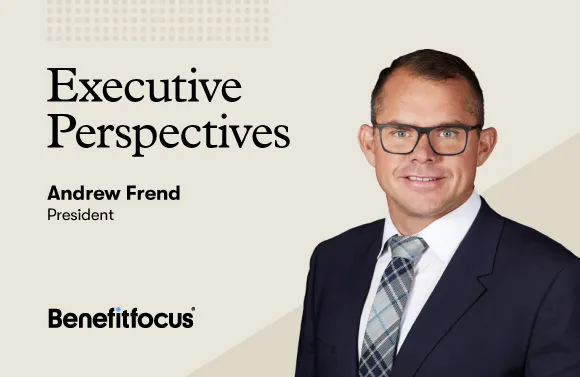
In this edition of Executive Perspectives, Andrew Frend, Benefitfocus President, shares his thoughts about how the benefits industry is changing, growing and poised to make a bigger and more valuable impact on the lives of employees and health plan members.
Q: Where do you think the industry will be within the next five years?
A: The biggest change that I believe is happening in benefits and HR technology is a shift FROM employers believing more is better – more products, more services that promise improved wellness or lower costs – TO employers wanting to simplify their benefits ecosystem by offering solutions that have proven value and are integrated in a way that simplifies both the employee experience and the administrative burden on HR teams.
Driving this evolution are a number of factors, including smaller HR teams with expanding scopes of responsibility, more challenging procurement and agreement frameworks with increased focus on data security and privacy, pressures, and fatigue around disconnected point solutions that don’t end up improving outcomes because of poor engagement.
Winning benefit and HR technology providers will prove the ability to drive improved outcomes for employees and their families because they can:
- engage the right person with the right solution at the right time.
- drive personalized decision making across increasingly complex solutions.
- make taking the right action simpler through integrated technology and service delivery models.
Companies – and this also holds true for health plans – want their data in fewer places. They want agreements with fewer providers. They want everything to work together in a way that demonstrates improvements for their member population in terms of health outcomes, financial outcomes, mental health outcomes and anything else included under the health banner.
Q: What trends do you think are helping to define a successful employee/member experience?
A: Our business is a ‘win by inches’ game. The successful companies will be those that continuously deliver on the fundamentals, whether that's benefits administration, retirement record keeping or an insurance company paying claims. Benefit providers and HR technology platforms need to execute on the fundamentals in order to earn the trust and right to bring innovation to employers and their employees. A successful customer experience begins by not making the simple things difficult and causing frustration. That is step one.
From there, we as an industry need to shift from a product-based to a goal-based, customer-first model. Rather than leading with why a product makes sense and positioning feature-based engagement, how can we understand an employer’s or employee’s specific needs and goals and design solutions that increase the probability that they can solve a particular problem or achieve a specific goal. This also requires understanding the constraints that a customer may have, whether that be budgetary or otherwise.
This leads to a third principle in a successful customer experience, and that is personalization. One of the biggest challenges in successfully engaging customers is requiring them to sort through a myriad of options and choices across multiple applications to find what may help them. It is imperative that we provide the right solution to the right person at the right time. There are many solutions in the market that can both improve the wellness of an employee/family and reduce costs for them and the employer. There are diabetes assistance programs, musculoskeletal interventions, mental health programs, smoking cessation programs, etc. How can we as an industry greatly simplify the connection of the person to the solution in a much more personalized way, increasing engagement and thereby improving outcomes?
Q: What keeps benefit leaders up at night?
A: Prioritization is a big one. Benefit leaders have all these things they want to do, but they have to keep doing the basics – handling service matters, supporting open enrollment, bringing on new hires and so on. All these normal day-to-day functions get in the way of the more strategic work they want to be doing, like improving the wellness of their population, improving productivity and attracting and retaining talent.
This reality is what’s motivating HR leaders to seek a partnership with a technology and service partner that can help execute and even automate administrative processes and free-up resources to focus on higher-impact initiatives.
The other thing is inflation in health care. The thesis right now is there are some pent-up costs resulting from inflation that are not showing in health care costs yet because they’re generally set for a three-year period. Those increases will start to bleed through in the next couple of years as some of these contracts get renegotiated.
A lot of people are predicting that medical expenses will jump back up to pre-pandemic levels. That would be a big problem for employers, because if medical costs are going up much faster than revenues, then something has to give.
Q: How can employers and health plans demonstrate the value they offer members or employees?
A: The value people attach to their benefits is relative to how well they understand them. In general, well understood low-quality benefits are actually valued more highly by employees than poorly understood great benefits. Even if an employer can't afford to have best-of-breed benefits, they can still invest in helping employees deeply understand their benefits and get the maximum value from them in terms of attracting and retaining talent while improving productivity.
Of course, it’s one thing to say it, and another to get it right. Benefits are complicated, and employees don’t have limitless time or capacity to research and understand their options, so we have to make it easy for them. Beyond things like call center support, having a good benefits administration or enrollment solution helps a lot because it’s the main way employees interact with their benefit programs. Built-in decision support and care navigation tools go a long way to helping employees choose the right benefits and use them properly once they have them.
Finally, it doesn’t hurt to remind employees about the contributions you make, so they don’t see benefits as purely a cost to them. One tool to help with this is using total compensation statements to show how much you’re really spending on each employee beyond their salary. This, combined with the benefits experience you provide to help them choose and use their benefits, can help boost their perceived value of their overall benefits package.
Q: What quick wins do you see that can help benefits professionals during the 2024 benefits open enrollment season?
A: Keep the employee experience in mind. When employees interact with benefit service centers, they often link their experiences to their employer rather than the providers. If they have a negative experience, they tend to blame the employer rather than the service provider, and it all lands at the feet of the HR team.
The only solution to this is to protect the employee experience by being very careful about which benefits providers you allow to engage with your employees. And this means choosing the right partners to help support them along every touchpoint, both digital and person-to-person. This is something you can start evaluating now, before moving into planning for the 2025 benefits year, which will be here before we know it.
In the days leading up to open enrollment, it’s always good practice to review your employee communications to make sure they’re clear, concise and actionable. It’s a very basic step, but it’s not necessarily easy. Getting your communications right – from messaging to media – can really help employees focus on dates, deadlines and other important benefits-related information that will ultimately help shape their benefits experience in the year ahead.
Q: What does the future of workplace benefits look like in 5-10 years?
A: Employers will increasingly demand that suppliers can provide more than fancy features. They will want to see empirically how those features translate into making their people better.
There are scenarios where the cost of health care continues to grow faster than GDP. And then you throw in some of these very significant high-cost pharmaceuticals and genetic interventions that are incredibly expensive. Even the largest self-funded employers are going to have a hard time absorbing that cost, particularly when it’s so unpredictable from year to year.
One option is for employers to fund individual coverage HRAs (ICHRAs) in lieu of a group health plan for the express purpose of buying a health plan through a trusted marketplace. I don't see that as an imminent massive shift, but I do see it growing over time.
There’s also the evolution of the benefits experience toward a more familiar and streamlined online consumer experience. Today, in our world, there's a lot of complexity in the benefits “supply chain” because of what sits between a product manufacturer and a consumer. The product is effectively the service an individual receives at a hospital, but then you have insurance companies, PBMs, advisors (brokers and consultants) and even your CFO and HR team. Relative to direct-to-consumer categories, innovations take time to work their way through the ecosystem. But the beauty is that we have very discerning, expert customers and advisors that help multiply the impact once innovation is proven to have real value. It’s a bit of, “go slow to be able to go fast.”
Q: How important will advisors (brokers and consultants) be over the next decade?
A: Advisors play an essential role in helping employers with their health and benefits strategy. Employers have all these regulatory frameworks to worry about, like ERISA, HIPAA and FINRA, plus many new leave laws coming up. Navigating these complexities requires an incredible amount of intellectual capital, and employers will rely on advisors to help them.
Sometimes carriers and HR technology companies think of advisors as the people who send out an RFP and beat them up on price. But realistically, provider selection is a fraction of their job. As experts on the many solutions available in the marketplace, advisors help their clients sort through the complexities of identifying partners, making purchasing decisions and implementing and integrating new technologies. On top of this, they have become a legal resource, an HR resource and a financial resource, and their role in helping their customers navigate the benefits landscape – and drive meaningful outcomes – is only going to strengthen, which will add value across the ecosystem.
Q: How will AI affect HR and the wider business?
A: Emerging technology in the AI realm could really change the game for member experience. A challenge we have in this industry is that a ton of data is needed to make decisions, and it’s held in many different places. That makes figuring out the optimal actions in any given situation very difficult. That’s not to say it can’t be done, but it will take time to train language models that work well for our industry. Once it’s in place, though, it could have a very high utility for members and really improve their experience.
If a call center employee can use AI-powered tech to quickly navigate through multiple systems and answer a question for a member, for example, they can focus on delivering a higher-value, more personal moment for the caller. That’s powerful. Transforming a too-often frustrating and time-consuming process into one that’s friendlier and faster can have a wide-reaching impact for both people on that call.
Beyond that, AI has the potential to help companies grow by enabling employees to be more productive and innovative. When automation frees up an employees’ time and energy, they’re able to use and build on their unique skillsets to take on new responsibilities and solve different types of problems. The emphasis here is on engaging employees in more meaningful, valuable ways – not in reducing headcount, but in making better use of each employee’s capabilities to drive business forward and make a bigger difference in the lives of customers.
Finally, safety. There’s a balance to be struck between trying to capitalize on these technologies to avoid falling behind, but without making any serious mistakes or compromising ethics. It’s the typical balance of risk versus reward, and a lot of companies will be asking themselves right now where to draw the line.
We’re in this period where everyone wants to say they're leveraging generative AI capabilities and riding this wave of energy, but it's still early days. No doubt we’ll see the wheat separated from the chaff over the next couple of years.

